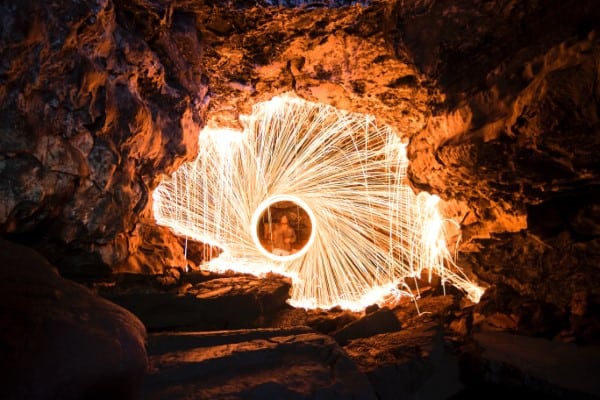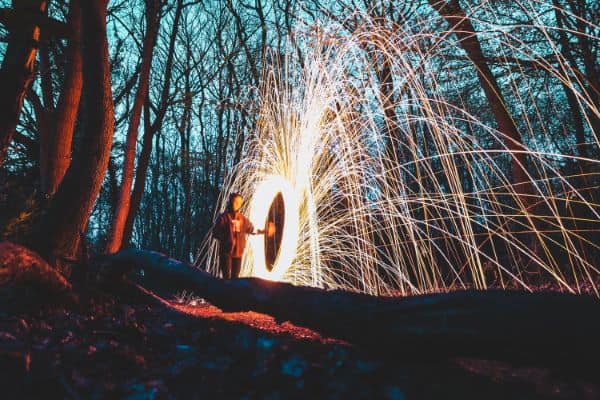When Ironing Wool Does It Burn Easy
Whether you're trying to pull off a cool party trick or wanting a really interesting photo, lighting up steel wool and letting the sparks fly is a lot of fun.
But why does steel wool burn? Iron is actually a flammable substance. Steel wool, which is primarily iron, has a very high surface area that exposes it to oxygen. Combine that with the thin fibers that quickly transmit heat and you can maintain combustion.
Why Blocks of Steel Don't Burn
The reason that a block of iron or steel doesn't burn is that it's really hard to get the oxygen molecules close enough to the iron to react.
Compare that to highly combustible materials, like wood. Wood actually lets out combustible gases as it burns, which react immediately with oxygen.
Iron doesn't do this. Since our atmosphere is only 20% oxygen anyway, it takes some special measures to get enough oxygen to react with iron to cause combustion.
Why Steel Wool Will Burn
Steel wool is very fine, so it has a lot of surface area. This means that a very high percentage of the iron molecules are exposed to air, which contains oxygen.
When you light up steel wool, generally it will burn red for a little bit and often go out unless you do something to help it along.
If you blow on it gently or expose it to some kind of windy conditions, it'll burn until all the iron is oxidized.
Fun fact: When iron burns, it becomes iron oxide (basically rust). This means that oxygen atoms have joined themselves to the iron. So instead of burning away and getting lighter, the steel wool actually gains mass and gets heavier from this addition of oxygen molecules. Kind of counter intuitive, isn't it?
How to Get Steel Wool to Burn
This is super easy, and you can do it with nearly any energy source.
The simplest thing to do is to just use a lighter to get it going. The fine strands of steel get red hot almost instantly, so light them up and just blow gently on them.
Another cool trick is to use a battery. 9 volt batteries work best, since the terminals are so close together. Just push the terminals against the steel wool, and the electricity going through the wool will be enough to turn it red.
If it's not working right away, try isolating a few of the strands of steel wool. If you have too much contact with the battery terminals, then electricity will be spread over too much steel, so it won't get as hot.
This is an excellent camping trick. You can start a fire in the wild within seconds using steel wool, since it burns so hot.
Cool Tricks with Steel Wool
One of the coolest things you can do with steel wool is to spin it around at night and let sparks fly everywhere.
To do this, all you need is a metal whisk with a hole in the handle end, a lighter, safety glasses, and a dog leash. And, of course, steel wool. The finer the better.
There are other ways to do this, but these are things that most people already have on hand.
Put the steel wool inside the whisk like it's a cage. Clip the dog leash into the hole in the handle end of the whisk. Put on the safety glasses.
Make sure that you're in an area that won't burst into flames. Don't do this in your living room. Please do not start a forest fire for the sake of an Instagram pic. Flying sparks are hot and can easily cause fires.
Hold on to the leash, letting the steel wool in the whisk hang down. Light the steel wool.
Now spin it around in a large arc.
For the photo, you can get really amazing results by using a tripod to stabilize the shot and having a long exposure time, like 20-30 seconds. It's also a lot of fun to do this in interesting areas, since the light from the sparks and long exposure will also reveal the area around you.
Here's an example of the kinds of shots that you can get:

There's a lot of photography where people are doing this in places like forests, but please be extremely cautious if you choose to do this.
If anything, only do this after heavy rainfall when the chance of forest fire is very low, and have proper fire extinguishing equipment on hand. Chunks of steel wool can potentially fly out and ignite something that can smolder for hours after you've left, and next thing you know Australia is on fire… again.
Even still, you get awesome shots.

Just be responsible.
Do Other Metals Burn?
Absolutely. Some will actually burn even in solid block form.
Magnesium is one example of this. If you get magnesium hot enough, it will ignite, burn blindingly bright, and be extremely difficult to put out.
Here are some common other metals that can burn:
- Aluminum
- Titanium
- Cobalt
- Lead
- Tin
- Zinc
- Copper
For pretty well all metals, though, the same principle applies: You need to be able to get enough oxygen to be in direct contact with the metal.
The most combustible metals will burn as thin wires or strands. For example, thin titanium strands are very easy to light up.
Others explode violently when in powder form. This can be a hazard for manufacturing plants – dust collectors for aluminum powder (like from sanding) can blow up an entire facility if not properly handled and maintained.
The most common place that you'll see this though is in fireworks. Different metals will burn in different colors.
For example, titanium burns very bright white. Copper oxide is blue. Other, less common metals, like calcium and barium, burn orange and green respectively.
Fun fact: Metals are elements whereas minerals are compounds of various elements. So if you were wondering why I classed calcium as a metal instead of a mineral, calcium is a metal in its pure state. It's rare to find it in this pure state, though, so we typically interact with it as a mineral.
If you want to learn more about different kinds of everyday metals along with some interesting facts about them, then you'll probably find this post interesting.
Source: https://makeitfrommetal.com/why-does-steel-wool-burn/
0 Response to "When Ironing Wool Does It Burn Easy"
Post a Comment